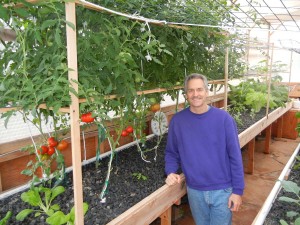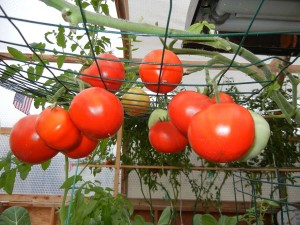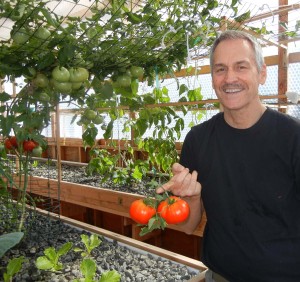Growing Tomatoes in Aquaponics
-by Colle and Phyllis Davis
(Photo above) Each of these tomatoes weighs approximately 1/2 pound. We harvested them from a Farms® Aquaponics System. THEY ARE DELICIOUS.
Tomatoes are the single most requested crop to grow in the Portable Farms® Aquaponics Systems. The expected yields in this article are based on growth from a single Grow Tray (shown below) and are very conservative. They are based on the lowest yield per plant, the shortest harvest cycle and the longest time a plant will remain in the Grow Table of the system. The actual production and yield is often two to four times the stated amounts in most cases especially after the operator becomes more skilled.
Colle Davis harvesting tomatoes
Tomatoes that have been planted and raised from a Portable Farms® Aquaponics Systems can be sold as locally-grown and pesticide free and after certification can also be called ‘organic’ meaning the grower can receive higher prices based on their growing methods and further reducing the ROI than stated in this article.
 Tomatoes present an interesting opportunity because of two factors: The first is that all tomatoes must be staked or trellised (vertical growing) to maximize yield. This keeps the plants upright and allows the utilization of the entire column of growing space from the Grow Table’s surface to the area 2m (6 feet) or more above the Grow Tables. Trellising can be seen as a type of natural vertical gardening. Trellising also makes harvesting much easier because the fruit is more readily accessible. Pollination is also easier due to the open access to the blossoms. Circulating fans are very effective in the pollination of most plants and reducing the humidity and heat when the plants’ blossoms are opened up on trellises.
Tomatoes present an interesting opportunity because of two factors: The first is that all tomatoes must be staked or trellised (vertical growing) to maximize yield. This keeps the plants upright and allows the utilization of the entire column of growing space from the Grow Table’s surface to the area 2m (6 feet) or more above the Grow Tables. Trellising can be seen as a type of natural vertical gardening. Trellising also makes harvesting much easier because the fruit is more readily accessible. Pollination is also easier due to the open access to the blossoms. Circulating fans are very effective in the pollination of most plants and reducing the humidity and heat when the plants’ blossoms are opened up on trellises.
To successfully grow tomatoes and other blooming plants (peppers, cucumbers, beans, etc.) year round requires the use of Grow Lights suspended above the Grow Tables in a climatically adapted environment. The investment in the Grow Lights and electricity for the purpose of growing blooming plants is offset by the increases in both variety and production.
One of the challenges with tomatoes is to determine how long to leave the plants in the gravel before removing them and replanting in the same spot in the gravel. The recommended spacing on tomatoes is 30cm (12 inches) and not to offset the rows for maximum outreach of the plant’s growth. Our research discovered that the plants begin to produce tomatoes at 81 – 89 days (depending on conditions) but after approximately six to eight months of growing in the gravel, the tomato plants develop such a large root ball (the size of a football) that they began to impede the effective flow of water through the Grow Tables. This is especially true when a Grow Table was planted with only tomatoes. This root ball’s large sized necessitates the removal of the mature tomato plant after the sixth to the eighth month. The immature tomatoes can be harvested before the plants are removed to add to the overall production. The gravel in the area is then cleared of root fragments, and a new plant is immediately placed in the same spot. This process is thoroughly and carefully covered in the Operations Manual© provided with each installation.

Colle Davis, Lead Inventor, CEO of PFAS LLC, standing in front of a few tomato plants (10′ tall) that supply hundreds of tomatoes while they’re planted in a Portable Farms Aquaponics System. We generally leave the tomatoes in the grow trays about six months and then replant new tomatoes because their root systems grow too large (size of a football) for the grow trays.
Tomatoes from a single full size 5′ x 40′ (200 sq ft) or 6’ x 32’ [1.5m x 12m (18m2)] Grow Table:
- Each Grow Table can hold 200 plants (1ft or 30cm centers) and be planted twice per year
- Production (harvest time) is normally over a 60 to 85 day period
- The plants require a three month growing period before harvest begins
- Year round growing is accomplished with the use of grow lights above the Grow Tables and a carefully acclimatized greenhouse or warehouse structure
- Tomato plants bloom to fruit ratio is increased greatly with the addition of FF Mineral Rock Dust. FF Mineral Rock Dust provides aquaponics growers the perfect balance of many trace elements not consistently available from just plain ordinary fish poop. Now you can grow consistently blooming plants with the addition of FF Mineral Rock Dust, as your plants and your fish poop will now contain adequate levels of calcium, iron, magnesium and potassium, just to mention four of the vital elements for successful growing in aquaponics.
- Staking or trellising is required and can be installed permanently
- No pesticides, fungicides or artificial fertilizers are ever used
- Tomatoes yield is between 5 and 9 lbs. [2 and 4k] per plant depending on variety
- Yield per plant is 25 to 35 tomatoes per plant, depending on variety
- Yield 55lbs [25k] per week
- This level of yield give one 880 lbs. to 1,760lbs [400 to 800k] every six months
- Or in one year 1,760 to 3,500lbs [800 to 1600k]
- PLUS 330lbs [150k] of Tilapia per year from the Fish Tank below the Grow Table
Each Module contains one Grow Table, one Fish Tank and one Clarifier. The components to make the Module functional include the Portable Farms® Kit with the special pump and valve system, a control panel, air pumps and related hardware and wiring.
Each Module cost approximately US$3,300 completely installed. This does include the growing medium (gravel), but not the seeds or fish because the owner will be in charge of the seed variety and the fish will be procured locally at best prices. The Modules require being housed in a climatically adapted greenhouse with one or more thermostatically controlled exhaust fans. In cold climates, more insulation is needed and in the tropics, the sides can be screen or netting.
By using the lowest yield with the shortest harvest season and two crops per space per year the Return On Investment will be approximately 55lbs per week at US$1.00 (very low price) or US$55.00 per week x 52 weeks = US$2,860 or a 1.4 year pay back. This does not include the greenhouse. In most cases this number will be much higher and will continue to rise as the operators become more skilled.
Please note: The above numbers are based on the lowest expected yields from field grown crops, using the shortest possible harvest time, plus the longest time from transplant to finish harvest. In other words, the lowest possible output from the Module for this crop is shown. The actual output from each Module can, and probably will be, from two to four times as high resulting in a much shorter ROI.


25 comments
Skip to comment form
I live in south Florida, 30minutes north of West Palm Beach.
Is the portable farming different here?
Author
Chris: Our farms are in 16 countries and all 50 US States. The greenhouse in Florida must provide sunblock and fans to keep the interior around 85 to 90 degrees F. We lived in Cape Coral for 18 months and built two Portable Farms on our screened Laini. We built roofing to protect the farms from the rains, but they were both successful farms. Hope this helps.
I see a lot about winter growing. I live in south Florida. Is it too hot here? I am on the east coast 1/2 mile from the beach about 30 miles north of west palm beach.
Author
Chris: Food is grown in greenhouses in all climates but the caveat is that those greenhouses must be acclimatized to create growing conditions in each climate whether it’s in freezing temperatures or tropical. We lived in Cape Coral, Florida, for a few years and built a two small Portable Farms on the lanai of over our swimming pool and provided paid tours of the farms. It did fairly well! If you’re interested in greenhouse growing, you’ll need sunshade inside the greenhouse, swamp coolers and fans inside the greenhouse to keep the temperatures under 90 degrees F.
Hope this helps.
I am inrashed in aquaponics
Author
Thank you for our interest in Portable Farms Aquaponics Systems.
Phyllis Davis, President, PFAS LLC
It’s not actually the poop where the magic happens. Ammonia is a byproduct of the fish breathing.
Author
Yep, true.
Most people don’t know that and our website needs to reflect this difference.
Thanks.
I am not using the grow bed mothod, instead I am using the Dutch bucket method, my question is, which is more productive in terms of number of plants per a green house regardless its measurements and if I could still use your average calculations in my speculated numbers on my greenhouse
Author
JoJo, no, our calculations are vastly different from the Dutch bucket method. I seriously doubt Dutch Bucket Method is more productive than grow tables. Our research is based on at least 100 variables including grow-table space, fish stockage and effluent ratios, pumping methods and more. You do NOT have our permission to use our research and measurements for your purposes. We’ve worked long-and-hard to create our benchmarks and our published research is proprietary to PFAS LLC. If you have any further questions, we will happy for you to work with our legal department. I’ve passed your question along to them. – Colle Davis, CEO, PFAS LLC
I live in Colombia, the lowest temperature here is 85° F every day of the year and 11 hour of strong sunlight 340 days of the year. What would tomato yield be per 100 square meter coupled with 100 cubic meters of tilapia tanks?
Thank you very much.
Author
Chris: We are having a sale- August 2 – 6, 2021. Visit the link to learn more: https://portablefarms.com/2021/portable-farms-sale-august-2-6-2021
Our NEWLY REVISED 2021 ONLINE self-paced aquaponics course contains all we’ve learned in our 49 years in the field of aquaponics and includes a Portable Farms® Kit containing the technology that is the ‘heartbeat of the system’ that allows our systems to grow such beautiful food and healthy fish.
In celebration of Portable Farms® 13th Year Anniversary, we’re offering
the sale of One Portable Farms® Course and Kit for $1,399.00.
Buy one Portable Farms® Course and the Kit – $1,399.00
or Buy Two Portable Farms® Courses and Kits – $1,999.00
O’fish-ally Your Friends,
Phyllis and Colle Davis
What do you use for pest control?
Author
Byron,
Screened openings, air lock doors, and very focused local picking bugs off and a light organic spray occasionally.
Colle
Colle,
I think there was a miscommunication on May & Peter. Their 350 sq meter building is equivalent to 3,767 sq ft. Unless I’m missing something, that will accommodate quite a bit of production.
Author
Joe,
Nice catch. Thank you for catching my mistake. Here are the correct figures:
350m2 will accommodate 10 Portable Farms Modules. Taking the Aquaponics University Course, $2,500 plus approximately US$750 for material for each Module, plus the US$1,300 each for the additional 9 Portable Farms Kits equals – US$22,700 PLUS your warehouse modification cost.
Colle
Greetings Mr. Davis,
Thank you for all the info. provided.
Just wondering how much water will a system of one 18m2 grow-bed hold, along with the fish tank and all…
Thanks,
Antony
Author
Tony,
The initial amount of water to begin operating the PFAS Module is 1,600 liters (430 gallons). Under the most adverse conditions of very high heat and low humidity the maximum water usage per day will never exceed 100liters (30 gallons). Under normal conditions the water usage (from transpiration only) is less than 30liters (10 gallons) per day.
Colle Davis – Inventor
How many heads of iceberg lettcus or red lettcus can you grow in your tray system
Author
Michael,
The number of plants depends on the size of the Grow Tray, the variety of the lettuce, the temperature, the available light and the time of year. The Operator is critical in the overall success of the Portable Farms® Aquaponics Systems and that’s why we train everyone who buys the PFAS. The longer the systems run and the more experience the Operators have the more ‘crowded’ the Grow Trays can be and raise the output.
Colle Davis – Inventor
If I can keep the summer temperature year round do I have to replant the tomatoes? Couldn’t I keep harvesting after the crop has matured to fruiting size? I am guesstimating with ideal conditions/plant/nutrition your yields are closer to 10 lbs a plant, a month, is that correct?
Author
Albert,
The temperature in the climatically adapted greenhouse needs to be kept between 40 and 104 degrees. That is a huge range. By keeping the minimum temperature above 60 degrees your tomatoes will blossom and fruit better. We suggest the tomatoes be rotated out after six to eight months because the root ball gets so big it starts to impede the flow of water in the Grow Tray. The yield depends on the variety and how long you leave the plants in the Grow Trays.
I trust this helps.
Colle Davis – Inventor
Good Day,
We like to start aquaponic.
We estimate 650km south of Manila/Philippines. And the vegetables on our area is coming around
1000km from the north after Manila.
We like to produce first for our use.
Second for the Marketplace.
Like Lettuce, Tomatoes, Cucumber, Beans,etc.
We have estimate 350 Floor sqm old Building.
On this place we like to install Aquaponic System incl. With Tilapia Fish
( Tilapia Fishpond is outside, extra 200sqm )
Can you give us a price for this.
Thanks for al infos
May & Peter
Author
May and Peter,
Thank you for your inquiry. That is a very small installation and will barely cover your own needs. Having the Tilapia tank outside will create problems for you. Please see the price list for a better idea of what it will cost to install a Portable Farms™ Aquaponics Systems please see http://portablefarms.com/thank/pfapl.pdf .
Good luck.
Colle Davis – Inventor
Author
Joe,
Nice catch. Thank you for catching my mistake. Here are the correct figures:
350m2 will accommodate 10 Portable Farms Modules. Taking the Aquaponics University Course, $2,500 plus approximately US$750 for material for each Module, plus the US$1,300 each for the additional 9 Portable Farms Kits equals – US$22,700 PLUS your warehouse modification cost.
Colle